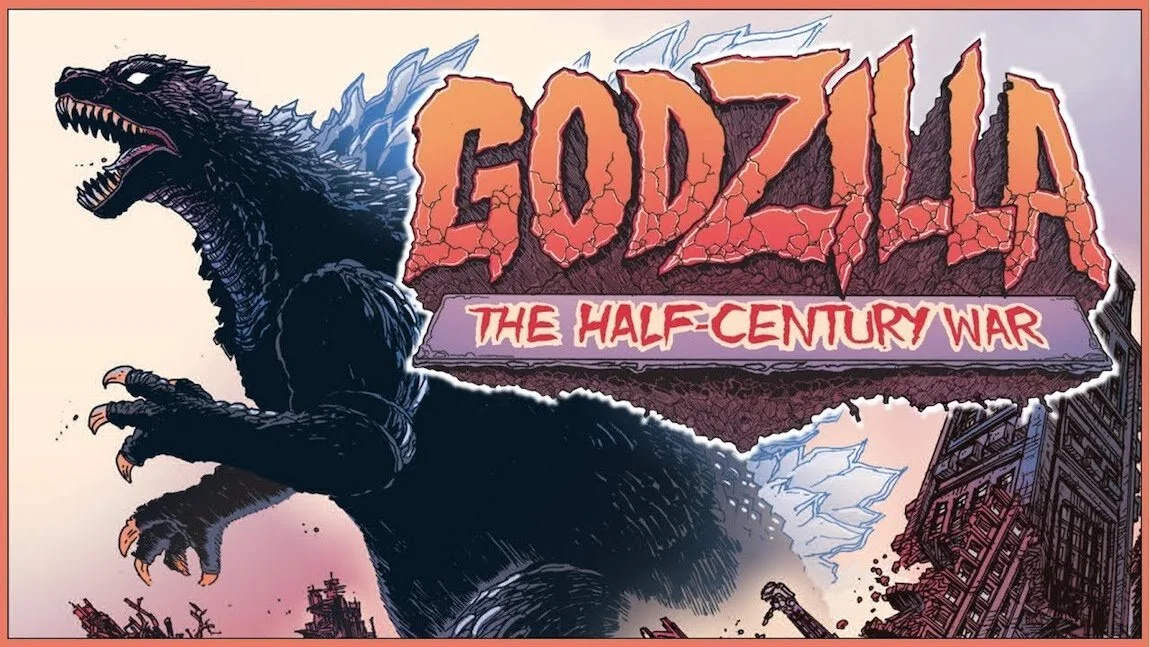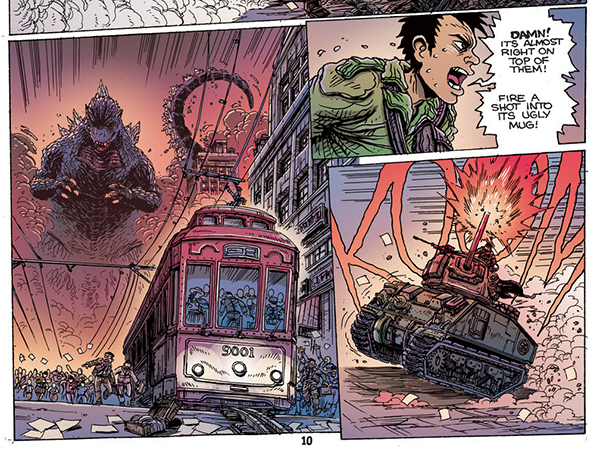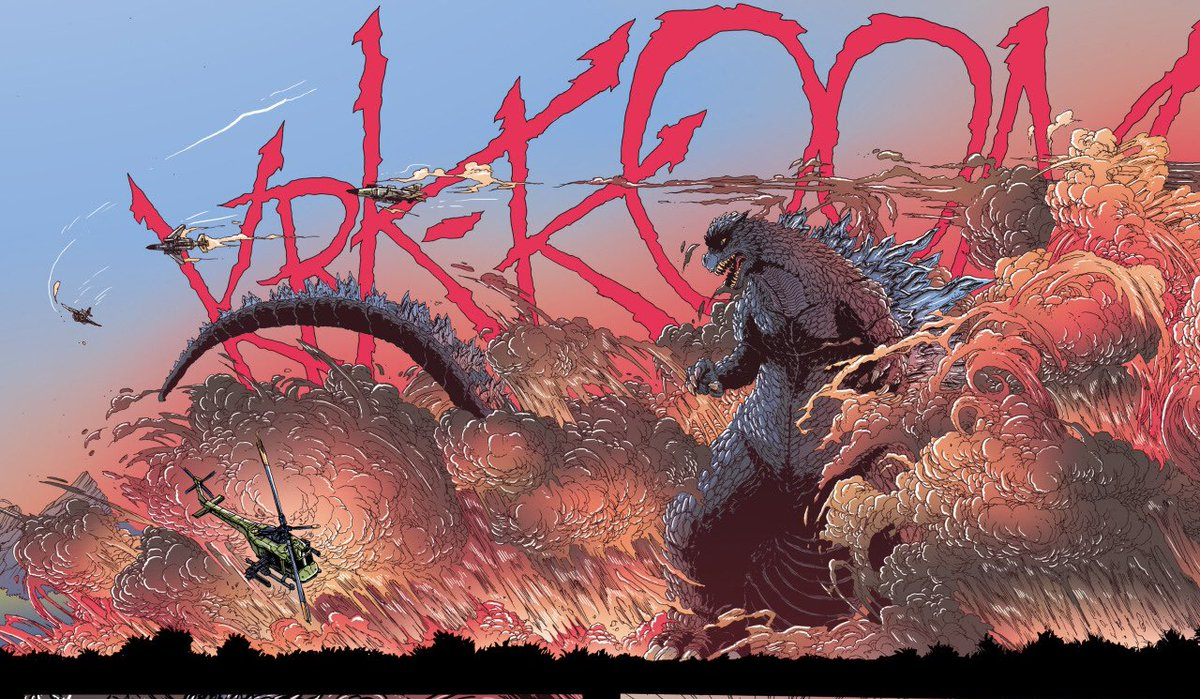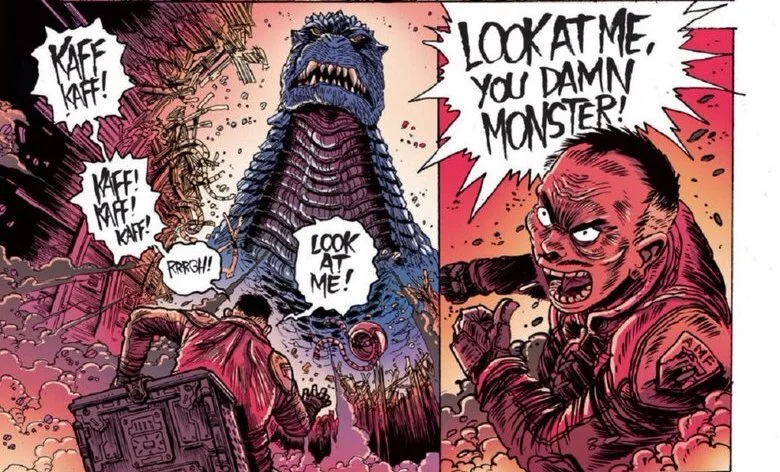Godzilla: The Half-Century War
Thanks to IDW, it’s not hard to prowl the comic racks for action involving the King of the Monsters. Ongoing series, mini-series and one shots featuring Godzilla and his many friends/foes made by a variety of talent—it’s safe to say that G-fans have been eating well in regards to finding Kaiju action beyond the silver screen. And that’s not even considering the other indie efforts that are out there as well. With so many comics from so many different teams telling so many different stories, it can be hard to really pick a favorite. Today, though, I want to talk about what I consider to be among the best IDW has put out: James Stokoe’s Godzilla: The Half-Century War. A brilliant miniseries that hasn’t left my mind since reading it for a number of reasons.
The Half-Century War is a self-contained story centered around Ota Murakami, a Lieutenant of the Japanese Self Defense Force, and his multiple encounters with Godzilla over the course of his life.
Each issue tells a story centered around a pivotal moment of Murakami’s life starting from his first time laying eyes on the king in the streets of Tokyo during Godzilla’s first rampage in 1954 to actually battling alongside him in 2001 to determine the fate of the Earth.
We see the formation of the Anti-Megalosaurus Force (A.M.F), an anti-monster task force and their efforts to not only find a way to stop the rising threat of Kaiju as more and more appear, but also to solve the mystery of a seemingly man-made device that is drawing the titanic creatures out.
The Half-Century War’s story is incredibly engaging. Moving at a brisk pace, each issue being filled with bombastic set pieces of Kaiju action but also the inner thoughts of Murakami and his interactions with those around him. Murakami is an interesting protagonist and, in a genre where human characters can be deemed as placeholders until the real monstrous stars show up, he makes for a very likable one as well.
The idea of someone seeking some form of revenge on Godzilla for the destruction he has caused has been explored before, but in Murakami’s case we see him go from wanting to take down Godzilla to respecting and even rooting for him. This progression causes Murakami to hit a specific sweet spot as not only a genuinely interesting protagonist but also a stand-in for us Kaiju fans who have such a strong love for these giant beasts who would be the stuff of absolute nightmares in real life.
You can put yourself in his shoes as you watch him age over the course of the series, his obsession with the giant lizard growing and taking precedence over seemingly everything else.
The progression of Murakami’s view of Godzilla changing over time parallels the escalating nature of the story.
In 1954, Godzilla is the only Kaiju as he tears through Tokyo; we then see Anguirus make his appearance in fitting fashion as the first monster to take on Godzilla—followed by majority of the other iconic Kaiju from Toho’s line-up including Mothra, Hedorah, and Gigan.
It’s a beautiful progression that functions not only as an incredibly fun story for Kaiju fans but also as a brief overview and celebration of Godzilla’s history, managing to create its own timeline from the beginning of the Showa era to the Millennium era with callouts to key characters and devices (such as Dr. Serizawa and the oxygen destroyer).
We even get to see the evolution of Mechagodzilla in his different forms!
Stokoe’s book paints a very interesting idea of what could have happened if the Godzilla series didn’t reboot but instead was one linear series and, while you can probably poke holes in it, it works exceptionally well.
The Half-Century War is an absolutely gorgeous book to flip through thanks to its artwork, also handled by Stokoe with coloring assistance from Heather Beckel. His unique blend of anime meets western cartoon character design philosophy along with his ability to draw incredibly detailed creatures and backgrounds makes his work feel quite like nothing else and that’s on full display here. Splash pages inspire a sense of awe at the sheer scale of destruction going on due to debris and smoke filling the pages, shades of red and orange create the atmosphere of being caught in a war zone as Kaiju stomp around.
One page in particular has been burned into my memory since reading it. In issue three (my personal favorite as it not only features some favorite Kaiju of mine but also the wonderfully cartoonish A.S.F teams whose members seem to reflect some aspect of the Kaiju they encounter), has a stunning page of Murakami looking out over the ruined city of Ghana which has become the focal point of an all out battle between the beasts. There’s an almost dizzying sense of detail that drives home how insignificant the human race is to these titanic monsters.
Every issue is filled with pages like these, ones where you have to just sit back and marvel at the craftsmanship needed to set a scene of giant monsters wreaking havoc. On top of all this you also have some great action sequences, panels with weight and movement behind them that feel kinetic and lively as the Kaiju brawl and the humans do their best to survive. It’s the total package in this writer’s opinion.
There is no shortage of great Godzilla comic books out there, but so far none of them have stuck with me quite like The Half-Century War. It feels like a love letter to the entire mythos of Godzilla, honoring the Showa, Heisei, and Millennium eras. Through its artwork and story, despite pages showcasing devastation, Stokoe tells a personal story relatable to any Kaiju fan: That obsession with these gigantic monsters who would probably sooner destroy us than ever return the respect we give them.









